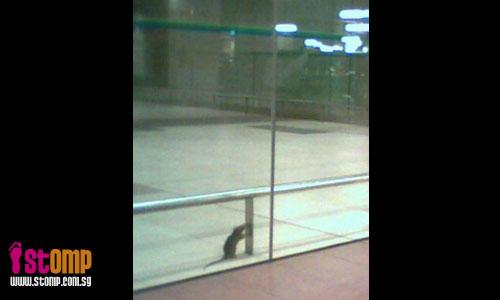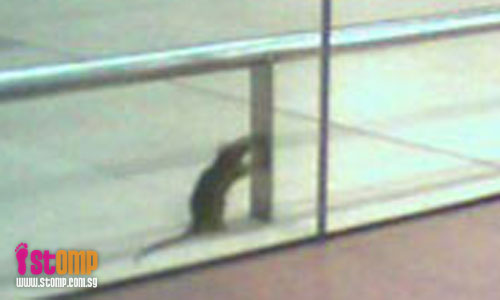
STOMPer Sammi was shocked to see this rat at Changi Airport's Terminal 3 at about 1am today (Mar 8).
She said:
"I went to Changi Airport T3 today morning at about 1am.
"While going back to the carpark at about 3am, we witnessed a rat running around one corner of T3.
"We were shocked to see a rat in such a clean airport.
"We even had time to take out our camera phone because the rat was buying time!"


While it is a little surprising to see a rat out in the open, I am not that shocked to find out that there are rats living in Changi Airport. It is usually next to impossible to prevent rats from moving into a new building. As long as there is food, the rodents will come. What's more important is ensuring that the rat population remains at a low and manageable level.
If I could hazard a guess, based on the size of the rat in the photos, it might be a brown rat (Rattus norvegicus), which is probably the most common urban rodent in Singapore.
Singapore's rats and mice belong to the Muridae, the largest mammal family, with over 600 known species distributed all over Eurasia, Africa and Australia.
Other rat species known to occur in Singapore include the Asian house rat (Rattus tanezumi) and the Polynesian rat (Rattus exulans). The Asian house rat used to be considered the same species as the black rat or house rat (Rattus rattus), but chromosome counts indicate that it is a different species altogether, and even in places where both species meet, very little hybridisation takes place. These 4 species are commensals of humans, and have greatly benefited from human activity. These species have followed humans all over the world, and have become established in places no rat could ever reach on its own, sometimes with profound and tragic ecological impacts.
Here in Singapore, the impacts of these non-native rodents on native wildlife is unknown. Given that Singapore does have quite a few species of native rodents, Singapore's terrestrial ecosystems are probably able to cope with these urban commensals. Urban rats also help to sustain populations of predators, from snakes and monitor lizards, to raptors and owls, to civets.
Besides the brown rat, Asian house rat, and Polynesian rat, Singapore has 2 other species of rat which are found in secondary vegetation, scrub, and abandoned plantations, the Annandale's rat (Rattus annandalei) and the Malaysian wood rat (Rattus tiomanicus). The forests of the Central Catchment Area are inhabited by the brown spiny rat (Maxomys rajah), while the red spiny rat (Maxomys surifer) might be locally extinct.
Singapore's final murid species is the house mouse (Mus musculus), yet another commensal of mankind that now has a near-global distribution.
It is interesting to me how conflicted we are about rodents. Many people find squirrels to be cute and harmless. Hamsters, guinea pigs, gerbils and chinchillas are extremely popular as pets. Fancy mice and rats are highly sought after as well. We anthropomorphise our rodents, and have over the years created a multitude of cartoon rats and mice to provide hours of entertainment. Yet people often regard the sight of a 'wild' rat or mouse with disgust and horror.
Maybe it's our old habit of associating these rodents with disease and death. Rats and mice do still spread a number of diseases, and in many cities, their numbers can explode. They cause significant losses of grain, and in some cases, will even prey on poultry, feeding on eggs and young chicks. In other words, we despise them for the fact that they have managed to survive so well and adapt to our presence, despite all our efforts to eradicate them.
Here in Singapore, rats and mice are more of a nuisance than anything else, although that does not stop us from trying to control their numbers. The burgeoning rat population in the Orchard Road area has made the news lately, although it is not surprising that the rodents should capitalise on littering and improper disposal of refuse. Recent control measures have taken their toll on the rodent population, although this has raised some ire over the cruelty of glue traps.
Ultimately, controlling rodent numbers means tackling human behaviour, and ensuring that food waste and refuse are disposed of properly. We can keep trapping and killing rats, but as long as the source of the problem is not tackled, we are only treating the symptoms.